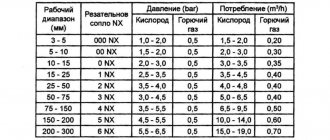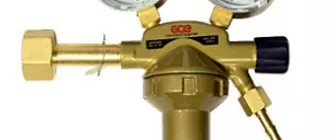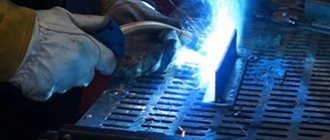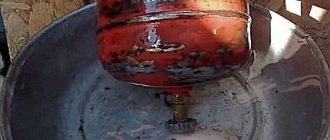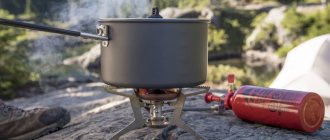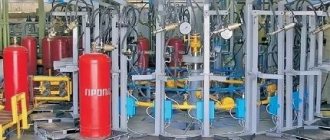Why do you need a reducer for a gas cylinder? The easiest way to answer the question is by comparing a household reducer for a gas cylinder with a mains voltage regulator. For a thrifty owner, the use of an electrical stabilizer has long become the norm. A gas reducer for a cylinder is used for exactly the same purpose - to stabilize the pressure coming from the gas cylinder to our household appliances.
Reducing gas pressure to operating parameters that ensure stable operation of the equipment - this is the main task performed by a cylinder pressure reducing device. The characteristics of the inlet pressure are important for household appliances where the energy source is blue fuel.
It would seem that after we have found out why a cylinder reducer for propane and butane is needed, we can finish the article, say goodbye to the readers, and submit the work for publication. However, not everything is so simple, and it turns out that the gas reducer operates according to completely two different operating principles and is divided into two types of devices.
Heating a country house with bottled gas
To create a high-quality heating system for a private home, gas boilers are usually used. Compared to alternative heating appliances, they are the most cost-effective and easy to use. But what about those who do not have the opportunity to connect a private home to a centralized gas pipeline? From this article you will learn whether it is possible to heat a house with gas from cylinders and how to properly set up safe heating with gas cylinders.
- What is more profitable - to use a convector or a cylinder?
- Proper storage is the key to safety
- Advantages of gas cylinder heating
- Disadvantages of heating with liquefied gas
General rules for choosing a balloon reducer
Summarizing the rules for choosing a gearbox for a gas cylinder, it should be noted that:
Classification of reducers for gas cylinders
- it is necessary to sketch out a diagram of the planned system from the gas cylinder to the end user;
- clearly formulate the following requirements for the device:
- Purpose.
- Operating pressure.
- Need for adjustment.
- Maximum volume.
- Method of connection to a gas cylinder and to a working device.
- Availability of maintenance and repair.
- Allotted budget.
- From the variety of products on the market, you should choose those that meet the stated requirements.
- Next, you need to enter the models and their characteristics into the comparison table and conduct a price analysis.
If devices that meet the stated requirements do not fit within the allotted budget, then it is necessary to either revise the budget or simplify the requirements for the device.
What is needed for installation and connection
You will need:
- gas stove for a summer house under a cylinder (configured for the use of liquefied gas);
- gas cylinder;
- gearbox;
- hose for connecting a gas stove or copper pipes of suitable diameter.
- 2 clamps for attaching the hose (on one side - to the adapter for connecting the stove, on the other - to the reducer);
- gas tap (not required, but recommended).
It’s already clear how to choose a gas stove; now we’ll figure out the rest of the components. Nothing complicated, but there are some peculiarities.
Cylinder material and size
First, let's talk about the material from which the liquefied gas cylinder is made. Until recently, there weren’t even such conversations. The gas cylinder was exclusively made of metal, and made of metal of decent thickness. Now there are also composite gas cylinders (also called Eurocylinders) and they are approved for use by gas services. If possible, it is better to buy just these. Why are they better? Here is a list of their advantages:
- 2 times lighter.
- They have a fusible insert that prevents explosion in case of overheating/fire.
- Allowed for transportation in regular cars.
- Do not accumulate static voltage.
- There are polymer cylinders with transparent inserts. They allow you to control both the degree of filling and the availability of gas.
The polymer cylinder has few disadvantages. The first is that it costs two to three times more than a metal one, but it is much easier to carry/transport. The second is that, with equal volume and dimensions, it is larger than its metal counterpart.
Now about the size of gas cylinders. The larger the volume of the gas cylinder, the longer the period between refills. But, on the other hand, larger volume cylinders have larger dimensions and weight, and are more difficult to carry/transport. In addition, it is easier to find a place for installation under a small cylinder.
In general, the choice is yours. Moreover, with the advent of composites, they appeared in different sizes - high and narrow, low and wide.
Gearbox
Why do you need a reducer on a gas cylinder? It performs several functions at once:
- Stabilizes the pressure at the outlet of the cylinder. The gas in the cylinder is under high pressure; for a stove it should be lower. This is what the gearbox does.
- When there is little gas left in the cylinder - 5-10% - the pressure reducer increases.
So the reducer on the gas cylinder helps improve safety and stabilizes the operation of the stove. It is better not to connect the stove without it. In this case, the more you open the tap on the stove, the more powerful the gas flow will come out. In addition to the fact that this is uneconomical, it can create a situation where the balloon starts to jump. In general, it is better not to operate it without a gearbox.
Please note that different types of reducers are used for metal and composite cylinders. Therefore, when purchasing, check the type of cylinder and its volume
And most importantly, to work with a liquefied gas cylinder you need a propane reducer.
Beware of gearboxes made in China....
If we talk about manufacturers, it is better to take Russian or European products. It's better to avoid the Chinese ones. Even those that have passed certification are made of very thin metal and quickly fail (begin to etch). In addition, many cannot withstand the size of the fittings. When connecting, this becomes a problem, since the hose is not put on tightly, and you have to somehow seal the connection.
Hose for gas stove
You can buy it in city gas stores or in construction stores/markets. But be sure to specify that you need it to connect a gas stove. It is correctly called a “gas hose”. The internal diameter should be 16 mm, the external diameter depends on the type of hose, and there should be an inscription on the surface (in yellow) stating that the hose is gas.
There are such gas hoses:
To connect the cylinder to a gas stove, you need a hose about a meter long - to fulfill the condition about the distance between the cylinder and the stove of 0.5 meters and leave some room for freedom of movement.
On one side, a union nut with a gasket should be installed on the hose. We connect this end to the outlet from the gas stove. If you just buy a piece of hose, you can install the corresponding gas adapter yourself by tightening the fastening with a metal clamp (don’t forget about the thick silicone gasket for sealing). On the other hand, the hose is connected to the reducer - it is pulled onto the fitting, then tightened with a clamp (do not forget to put the clamp on the hose and then connect it to the fitting).
How to choose a household propane reducer
The choice of a device for supplying a propane-butane mixture to gas-using equipment is based on two key parameters:
Sample passport for a gas stove
The operating mode of most household propane appliances is 30 mbar, 37 mbar or 50 mbar. Based on this indicator, the appropriate gearbox is selected. If its output pressure differs from the operating parameter of a gas stove, boiler or, for example, a grill, this may lead to improper operation of the equipment and even create an explosive situation.
The characteristics of the propane reducer can be seen on it - 3 kg/h and 29mbar
30 mbar, 1.5 kg/h (kg/h)
For stable and safe operation of the gas consumer, it is also important that its consumption does not exceed the performance of the gas reducer. In this case, the upper level of gearbox consumption is not standardized. That is, for a boiler with a power of 24 kW with a mass flow of 2 - 2.5 kg/h, it is permissible to install a gearbox with a capacity of 3 kg/h and higher - the automatic boiler or stove will still not allow “extra” gas to pass through.
0.45 m3 (for propane - butane)
1000 Pa - 1 kPa - 10 mbar
30 mbar - 0.03 bar
Some owners of autonomous gas supply systems make the mistake of purchasing industrial gearboxes instead of household ones, considering them more reliable. Firstly, such devices are an order of magnitude more expensive, and secondly, they are designed to work with more powerful gas equipment, so they are not always compatible with household appliances.
You should also pay attention to the type of thread of the device. Gearboxes designed to work with non-flammable gases are equipped with a right-hand thread, and with flammable gases they have a left-hand thread and a mark on the nut.
Required pressure and volume
The key characteristics of a gas reducer are inlet pressure, operating pressure and flow rate, or the maximum volume of gas passing through the device in an hour.
The inlet pressure is determined by the standard pressure in the cylinders and is usually 20 MPa.
Technical characteristics of gearboxes
The operating pressure for household unregulated gas reducers is set at 0.3 MPa ±5%
For adjustable semi-professional and professional adapters, the operating pressure is set by the user in the range of 0-0.4 MPa, and for certain high-performance models - up to 1.6 MPa
The consumption volume must exceed the volume consumed by the device (or group of devices) per hour.
Medium or low gas pressure. Which is better for the home?
In this article I want to talk about the difference in gas supply to a private home with medium and low pressure gas.
More and more often, cottage buildings in our country are gasified with a network of medium pressure gas pipelines (about 0.1-0.3 MPa, as a rule), rather than low pressure (150-300 mm per station). On the one hand, this is additional equipment (pressure regulator), and the gas pressure is higher, but on the other hand, considering how powerful gas boilers people install at home these days, medium pressure is the only way to supply gas in sufficient quantities to the end user.
When gasifying with low pressure, the pressure at the final device (for example, at the descent to the boiler), as it moves away from the gas distribution center (gas control point - a kind of local gas distribution center, in simple terms) will decrease. For example: if in winter the maximum possible pressure (low) at the outlet of the hydraulic fracturing unit is 300 mm. V. Art. (but again, this is the maximum permissible, as a rule, it is set in exceptional cases, in very problem areas), then with a gradual distance from the hydraulic fracturing, the user will have lower and lower pressure during the heating period, and according to our standards, even less than 120 is allowed mm. V. Art. Until severe frosts begin, there is usually enough pressure in the gas pipe for everyone. But as soon as the frost hits and everyone turns on their gas boilers at full power, the owners of cottages on the outskirts, at the most remote points from the gas distribution center (distribution center) - the gas pressure drops and drops. And when the pressure drops below the 120 mm bar. V. Art. Such happy owners of boilers, especially powerful ones, begin to have the following problems: the boiler either begins to go out periodically (not so bad, usually boilers with automatic ignition these days), or they get an error that there is no gas and do not turn on until the error is cleared.
When supplying subscribers with medium pressure gas, natural gas compressed to 0.1-0.3 MPa is supplied through a pipe to the house, again, the further from the hydraulic fracturing station, the lower the pressure, BUT! This gas pressure is only up to the personal pressure regulator installed at the inlet. Then the regulator reduces the pressure to low (approximately 200 mm Hg) and your boiler operates successfully without suffering from a lack of gas pressure. But this has its drawbacks. In Belarus, for the population, according to technical conditions, 2 types of regulators are included in the project: One regulator is GDGD 2.0, which is produced by Belgaztekhnika (the official description of it can be seen here) and the other regulator is ALSI FE-10 produced (its description can be seen here ). Their price is about 80 US dollars. Currently, as far as I know, they do not provide specifications for the installation of other regulators on the territory of the Republic of Belarus. So we have to choose the lesser of two evils (in the sense of regulators). But the advantages and disadvantages of each of these two regulators are in the following articles. But if there is a choice between what pressure gas pipeline to connect to the house, the choice in my opinion is obvious.
Source
Step-by-step instructions for connecting a gas cylinder at the dacha
Some stove models cannot be powered by bottled gas. High pressure is the main reason, and in the burners we can notice a yellow burning with the formation of soot.
By replacing methane nozzles with LPG nozzles, this situation can be changed. They are the same in shape, only the diameter is different. When connecting a new stove, there must be a set of jets to reduce gas. If a set is not available, jets can be purchased at reasonable prices.
The opening of the jets depends on the power of the burner and the gearbox itself. For using gas stoves, there are standard values for the diameter of the nozzle holes. Some manufacturers set their own diameter dimensions; nozzles that differ from these dimensions may void the warranty.
After assembling the installation, open the gas supply valve and use the reducer to set the required gas supply, that is, pressure. When gas passes through the system, all connections must be generously lubricated with soapy water and checked for gas leaks. If everything is fine, you can start lighting the fire. When the fire begins to smoke or has a yellowish color, it is necessary to reduce the gas supply, this is done using a reducer. When setting the minimum fire, all burners should be lit, but if one of them goes out, you need to adjust the low gas consumption knob on the stove tap. This can be done by increasing the pressure on the reducer.
Security zones
If complexes or buildings are being erected that are not involved in any way in the activities of the gas filling station system, compliance with the security zone is certainly taken into account, the length of which depends on the type of protected structure. Its dimensions:
- outside – 2 m on each side, even in cramped conditions;
- from underground - 3 m from the delimiting gas pipeline;
- CNG filling stations and gas filling stations are limited to a closed circle with a radius of at least ten meters from the established boundaries of the complex of capital construction projects.
Standard distances are the standard distance from the gas pipeline to communications. Water mains, power lines, roads and railway tracks must be located at a certain distance, which is regulated by a reference table. The minimum horizontal clear distances are taken into account (they depend on the pressure of the gas pipeline) and other existing requirements - electrochemical protection, climatic features, the presence of electrical installation regulations and high-voltage lines, etc.
The distance from buildings and structures to the gas pipeline must strictly comply with the standards. Distance standards are regulated by the pressure of the supplied gas and the type of gas pipeline constructed. For overhead low pressure, only a security zone is required due to existing operating rules. If necessary, it should be reconstructed.
Nuances
An additional application requires maintaining distances from boiler rooms, as fire-hazardous structures for industrial purposes. Two pipes - only 4 meters away from a residential building. Windows and roofing require at least 0.2 meters, and to the door - 50 cm.
Distancing from warehouses can be regulated by the enterprise, but it should not be less than in SNiP 2.07.01-89 and SP 42.13330.2011. The same applies to laying at the bottom of the slope, which can be regulated by builders and the Russian Railways administration (sometimes the distance from the gas pipeline to the railway tracks is reduced, but less than the norm is not allowed, especially near the embankment).
LPG tanks are taken into account separately. There are several types of them. For example, according to their orientation in space, they are divided into vertical and horizontal, depending on their location - underground and above-ground LPG tanks, single-wall and double-wall LPG tanks - according to the degree of endurance of the structure. The volume, location and type of complex regulate the distances. The standard GPC has a maximum pressure value.
Regarding tank installations, the standards of SP 62.13330.2011 are taken into account, but in each specific case the minimum distance is taken into account depending on the characteristics of a particular gas tank. Underground ones are deepened by 0.6 m, and the light distance between them is 0.7 m. A gas flow metering point is a prerequisite when using such installations; mixing stations, if necessary, are installed at 10 meters
A gas flow metering point is a prerequisite when using such installations; mixing stations, if necessary, are installed 10 meters away
Underground ones go 0.6 m deep, and the light distance between them is 0.7 m. A gas flow metering point is a prerequisite when using such installations; mixing stations, if necessary, are installed at 10 meters.
The design of buildings of any kind should be carried out near a gas pipeline only with the knowledge of regulatory and supervisory organizations, which calculate the norm depending on the type of structure and the supplied pressure of valuable chemical raw materials and fuel.
Adjustable reducer for gas cylinder
Adjustable gas reducers operate on the same physical principles as non-adjustable ones and have a similar design. The difference is that the compression force of the reducing spring supporting the membrane can be changed using an adjusting screw coaxial with the spring in the simplest models, or using a flywheel and a more complex mechanical transmission.
Adjustable reducer for gas cylinder
The principle of operation is that by changing the pre-compression force of the reduction spring, the user changes the threshold gas pressure in the working chamber required to operate and close the intake valve. A pressure gauge is also added to the parts, installed on the working pipe and allowing you to visually monitor the result of the adjustment.
Design features and maintenance
Problem-free operation of the system is impossible without regular maintenance and elimination of minor gearbox faults. To do this, you need to know the design of the device and the signs of typical problems.
Diagram of direct and reverse acting devices
According to the type of design, gearboxes are divided into direct and reverse acting devices. In the first case, the excess pressure of the incoming gas is directed to open the valve, in the second - the insufficient pressure in the working chamber of the device.
The design of single-chamber direct and reverse acting gearboxes is simple. The absence of complex components is the reason for a long service life without breakdowns if the product is made with high quality
The basic elements of both types of gearbox designs are the same:
- fitting through which gas is supplied;
- high pressure gauge showing the pressure value of the gas supplied to the device;
- a return spring that works to close the valve;
- high pressure chamber;
- a valve whose position regulates the volume of gas passed through;
- a safety valve that is triggered when unacceptable pressure is reached in the working chamber;
- low pressure pressure gauge, which determines the value of the working gas pressure;
- working chamber (low pressure);
- an adjusting screw that determines the position of the membrane;
- main spring;
- working chamber membrane;
- pin between the main spring and the bypass valve.
Reverse-acting gearboxes have become more widespread because they are more reliable.
There are models equipped with a pneumatic pressure sensor, where instead of the main spring, gas acts on the membrane, ensuring the balance of the system.
As a rule, the adjusting screw is tight. This is due to the prevention of spontaneous changes in position under the influence of forces directed at the membrane. When it rotates clockwise, the volume of the working chamber decreases and the pressure of the exiting gas increases.
In ordinary gearboxes, the unevenness of the output pressure depends on the value of the input pressure and, as a rule, reaches 15-20%. Two-stage (or two-chamber) models are used when it is necessary to maintain the exact pressure of the exhaust gases.
This oxygen reducer well illustrates the design of the two-stage type: at its core, these are two separate devices connected together
Such gearboxes have a more complex design and slightly larger dimensions. They cost more than their single-stage counterparts. Therefore, if there is no need, their use is inappropriate.
Periodic inspection and service work
For long-term and proper operation of the gearbox, it is necessary to periodically carry out simple procedures with it. Once a week you need to record the pressure gauge readings. As the elasticity of the springs decreases, a slow but constant decrease or increase in pressure is possible.
The following actions must be performed once a quarter:
- Check the tightness of the interface of the gaskets , safety valve and pressure gauges with the device body. This procedure can be performed by applying a soap solution to areas of possible gas leaks.
- Blow out the safety valve to prevent it from sticking. To do this, it is necessary to connect the gearbox to a source of compressed air and, with the outlet closed, increase the pressure until the protective mechanism is activated.
Repair and maintenance work that involves physical impact on the device body (including tightening threaded connections) cannot be carried out when the gearbox is under pressure.
This is dangerous due to the release and ignition of flammable gases. In addition, a sudden depressurization of the device may occur with possible physical harm to people in the room.
Gas service specialists are required to conduct an annual technical inspection of equipment, identify non-compliance with safety requirements and issue instructions with an algorithm for eliminating them
Typical faults and their repair
Gas leaks and pressure deviations outside the standard range can be eliminated independently. The first problem may be caused by the following reasons:
- depressurization of the housing;
- membrane damage.
The passage of gas through a loose connection of the housing elements can be eliminated by replacing the liner or using silicone sealant. The damaged membrane must be replaced with a similar element from the repair kit.
The reasons for deviation of the pressure value may be:
- Spring problem. It is necessary to disassemble the gearbox and determine the cause of the malfunction. If the spring is displaced, it must be corrected; if broken, it must be replaced. If there is a loss of elasticity, then it is enough to place a hard gasket under it.
- Leakage of compressed gas in devices with a pneumatic principle of pressure on the membrane. It is very difficult to fix the problem on your own. The gearbox needs to be replaced.
- Membrane problem. If a rupture occurs, it is necessary to replace the device assembly, and if there is a loss of tightness at the connection points with the washers, this malfunction must be eliminated by tightening the edges.
- Bypass valve problem. If the rubber gasket is worn out, it must be replaced. If the movement of the rocker arm is disrupted, the hinges must be replaced.
Considering the low cost of gearboxes, it is advisable to repair it only if a quick replacement is impossible. If, as a result of actions with the device, it was disassembled, then for safety reasons it is necessary to check its tightness during the first start-up.
Safety regulations
If you smell gas, you should immediately call 04 and open the windows
A gas stove of any type is considered a high-risk appliance, therefore, it is extremely important to take into account all safety rules, which include the following recommendations:
The walls of the room must be heat-resistant and withstand temperatures of 100 degrees; The kitchen set must also be heat-resistant and able to withstand temperatures up to 100 degrees; The kitchen set should be installed no closer than 45 cm from the work surface;; All sockets must be grounded; If you smell gas, do not turn on the lights. The gas must be shut off and the room ventilated immediately.
It is also important to call emergency services; Utensils for cooking on a gas stove should be chosen from aluminum, ceramics, cast iron or steel. You can also use Teflon cookware.
Rules for operating a gas stove
What is needed for installation and connection
- gas stove for a summer house under a cylinder (configured for the use of liquefied gas);
- gas cylinder;
- gearbox;
Gas stove for a summer house under a cylinder: connection rules when placing the cylinder indoors and outside
It’s already clear how to choose a gas stove; now we’ll figure out the rest of the components. Nothing complicated, but there are some peculiarities.
Cylinder material and size
First, let's talk about the material from which the liquefied gas cylinder is made. Until recently, there weren’t even such conversations. The gas cylinder was exclusively made of metal, and made of metal of decent thickness. Now there are also composite gas cylinders (also called Eurocylinders) and they are approved for use by gas services. If possible, it is better to buy just these. Why are they better? Here is a list of their advantages:
- 2 times lighter.
- They have a fusible insert that prevents explosion in case of overheating/fire.
- Allowed for transportation in regular cars.
- Do not accumulate static voltage.
Cylinders for liquefied household gas can also be composite (polymer)
The polymer cylinder has few disadvantages. The first is that it costs two to three times more than a metal one, but it is much easier to carry/transport. The second is that, with equal volume and dimensions, it is larger than its metal counterpart.
Now about the size of gas cylinders. The larger the volume of the gas cylinder, the longer the period between refills. But, on the other hand, larger volume cylinders have larger dimensions and weight, and are more difficult to carry/transport. In addition, it is easier to find a place for installation under a small cylinder.
In general, the choice is yours. Moreover, with the advent of composites, they appeared in different sizes - high and narrow, low and wide.
Gearbox
Why do you need a reducer on a gas cylinder? It performs several functions at once:
Stabilizes the pressure at the outlet of the cylinder.
- The gas in the cylinder is under high pressure; for a stove it should be lower. This is what the gearbox does.
- When there is little gas left in the cylinder - 5-10% - the pressure reducer increases.
Types of reducers for propane gas cylinders
So the reducer on the gas cylinder helps improve safety and stabilizes the operation of the stove. It is better not to connect the stove without it. In this case, the more you open the tap on the stove, the more powerful the gas flow will come out. In addition to the fact that this is uneconomical, it can create a situation where the balloon starts to jump. In general, it is better not to operate it without a gearbox.
Please note that different types of reducers are used for metal and composite cylinders. Therefore, when purchasing, check the type of cylinder and its volume
And most importantly, to work with a liquefied gas cylinder you need a propane reducer.
Beware of gearboxes made in China....
If we talk about manufacturers, it is better to take Russian or European products. It's better to avoid the Chinese ones. Even those that have passed certification are made of very thin metal and quickly fail (begin to etch). In addition, many cannot withstand the size of the fittings. When connecting, this becomes a problem, since the hose is not put on tightly, and you have to somehow seal the connection.
Hose for gas stove
You can buy it in city gas stores or in construction stores/markets. But be sure to specify that you need it to connect a gas stove. It is correctly called a “gas hose”. The internal diameter should be 16 mm, the external diameter depends on the type of hose, and there should be an inscription on the surface (in yellow) stating that the hose is gas.
There are such gas hoses:
Hoses for connecting cylinders to a gas stove look like this
To connect the cylinder to a gas stove, you need a hose about a meter long - to fulfill the condition about the distance between the cylinder and the stove of 0.5 meters and leave some room for freedom of movement.
On one side, a union nut with a gasket should be installed on the hose. We connect this end to the outlet from the gas stove. If you just buy a piece of hose, you can install the corresponding gas adapter yourself by tightening the fastening with a metal clamp (don’t forget about the thick silicone gasket for sealing). On the other hand, the hose is connected to the reducer - it is pulled onto the fitting, then tightened with a clamp (do not forget to put the clamp on the hose and then connect it to the fitting).
Decor
The design of a gas stove for a cylinder is nominal - there is no need to visit any authorities, the requirements are easy to fulfill. The first was announced - the distance to the cylinder is at least 0.5 meters. Second: there must be at least 2 meters to the main lines - water supply, sewerage, metal heating pipes. That's all.
There are two options for official registration:
- When you fill up a new cylinder at a municipal gas station (not for cars, but specifically for refueling household gas cylinders), the station employee will fill out the paperwork for you. You will need to provide the address (at least approximately) and explain where the stove is located and where the cylinder is located. Here you have to be careful, at least say that it is worth it according to the rules. Yes, the cylinder must be purchased at one of the Gorgaz stores and you will need the registration number of the car on which this cylinder will be transported.
Refill dispensers for gas cylinders
For many, a gas stove for a summer house under a cylinder has been standing for years even without such “design”. But in this case, you will refill the cylinder yourself, without using the services of municipal gas stations or exchange machines. Also, if it is necessary to repair or maintain the stove, or reconfigure it, you will need to somehow resolve the issue of design (usually there are no problems) or use the services privately.
Connecting the hose to the gas stove
To connect the hose to the stove, look at the back of the stove. Here you can see the inscription “exit”. You will immediately need to determine what type it is. Perhaps it will be made absolutely straight or have a slight angle.
This is very important, so the hose is not allowed to bend too much. If the pipe is located a little to the side, and the outlet is made straight, you will have to purchase an additional metal elbow with a thread. When the thread diameter is 3/4 inch, you will also need to install an adapter (foot) with a diameter of half an inch
When the thread diameter is 3/4 inch, you will also need to install an adapter (foot) with a diameter of half an inch.
Usually in all kitchens the gas riser is installed in a certain corner. A welded tube equipped with a ball valve extends from it to connect a gas hose.
The union nut is screwed onto the tap. When the faucet has an internal thread, the hose must screw into it.
Before connecting a hose to the “output” of the system, you need to install a paronite gasket. It is usually sold as a set.
But it is better to purchase such a gasket on the market, equipped with a metal mesh. It will serve as protection against possible contamination.
Having installed the gasket, the flexible hose is screwed to the outlet of the stove and tightened with an open-end wrench.
Then a gas leak check is carried out. All connections must be thoroughly washed. Open the tap and let in the gas. The absence of bubbles at the connections indicates that the system is ready for use.
Gas cylinder in the country - advantages and disadvantages
When a person just moves into a private house that is not connected to a gas pipeline, he finds himself at a crossroads - use an electric stove, or connect a gas stove, but use cylinders? Both solutions have a number of advantages and disadvantages.
The positive aspects of a gas cylinder are:
- A gas burner will heat everything several times faster. Cooking time will be significantly reduced, which means you will have more time for yourself or your family.
- The cost of refilling is much less than paying bills for used electricity. The only exception may be when you use electricity at preferential rates, for example, for people living in villages. There is also a discount on utility bills for those considered low-income.
- In certain regions, the rate of electricity consumption per person registered in the premises is limited to 50 kW per month, and if the limit is exceeded, the price increases.
Now about the disadvantages:
- Transportation costs, since there are gas stations, but they are much smaller than gasoline ones.
- It is impossible to know exactly how much fuel was filled into the cylinder.
- Installation of gas stoves in rooms where there is no ventilation is prohibited.
When we have figured out all the pros and cons, and you have decided to install cylinders, you can talk about where to place the fuel and stove.
How is the gas supply system organized?
Its hierarchy is determined by the classes of elements of the gas transmission network associated with the pressure of the pumped natural gas.
Principles of gas pipeline network design
The first level gas pipelines include gas communications in which the pressure of natural gas is high or medium. To eliminate dead-end sections, gas pipelines are backed up - duplicating individual segments or ringing. The creation of a dead-end network is allowed only in small settlements.
Natural gas under high pressure passes through several successive stages where its pressure is reduced. The process of reducing pressure at gas control points occurs intermittently, at the outlet of them the pressure is constant. In urban areas, gas communications with medium and high pressure levels form a hydraulically connected common network.
The use of hydraulic fracturing makes it possible to supply consumers with gas of different pressures, even if they are located on the same street - gas pipelines of unequal pressures are placed in parallel.
Second-level gas pipelines provide low-pressure gas fuel supply to the majority of consumers. Such networks are mixed, with a predominance of dead-end segments. Only the main pipelines are subject to ringing.
A low-pressure gas pipeline should not cross large man-made (highways, railway tracks) or natural (lakes, rivers, ravines) barriers. Installation of such communications in industrial areas is not allowed.
Gas networks supplying fuel at low pressure cannot form a hydraulically connected system for a large population center. They are designed exclusively as local complexes fed by several hydraulic fracturing units.
In turn, connected to medium pressure networks, which in turn, by analogy, are connected to high pressure mains. The third level of network gas pipelines is used at consuming facilities - on the territories of enterprises, in residential and public buildings.
The pressure requirement for such networks is determined by their purpose and the performance characteristics of gas-using devices (installations). Redundancy (partial duplication) on gas communications of the third level is usually not performed.
Features of using composite gas cylinders
Composite gas cylinders have recently become increasingly popular. This is due to their advantages over their steel counterparts.
- Weight. Almost twice as light as steel.
- Ease of handling. There are comfortable handles.
- Transparency. The fill level can be easily seen.
- Convenient storage. Can be placed one on top of the other and stacked.
- Life time. The service life is practically unlimited.
- Operational safety. It is caused by the absence of sparking and a safety valve and fusible link built into the gas cylinder.
Composite cylinders supplied to the Russian market are produced in the Czech Republic, Norway and India. When purchasing such a cylinder, it is necessary to clarify the connection standard. If the gas cylinder is equipped according to the Russian standard, you can use a regular reducer for the gas cylinder. If the gas cylinder comes with a European connector, then you will need to either order an adapter or purchase an imported reducer. Please note that each additional connection increases the risk of gas leakage.
Classification of gas regulators
| Model | Inlet pressure | Outlet pressure | Gas consumption | Availability of adjustment | Availability of pressure gauge |
| RDSG 1-0.5 Belarus | 0.07-1.6 MPa | 2000-3600 Pa | 0.5 m3/hour | No | No |
| RDSG 1-1.2 | 0.07-1.6 MPa | 2000-3600 Pa | 1.2 m3/hour | No | No |
| Milano under eyeliner | 0.03-0.75 MPa | 1960-5880 Pa | 1.5 m3/hour | Yes | No |
| Milano under the sleeve | 0.03-0.75 MPa | 1960-5880 Pa | 1.5 m3/hour | Yes | No |
| Italy 694 | 1.6 MPa | 2900 Pa | 1.5 m3/hour | No | No |
| Italy 694 d/composite cylinders | 1.6 MPa | 3700 Pa | 1.5 m3/hour | No | No |
| RDSG 1-1.3 China | 0.07-1.6 MPa | 2000-3600 Pa | 1.3 m3/hour | No | Yes |
| RDSG 1-0.5 China | 0.07-1.6 MPa | 2000-3600 Pa | 0.5 m3/hour | No | Yes |
| GOK EN-61 | 1.6 MPa | 3700 Pa | 1.5 m3/hour | No | No |
| GOK for composite cylinders | 1.6 MPa | 2900 Pa | 1.5 m3/hour | No | No |

